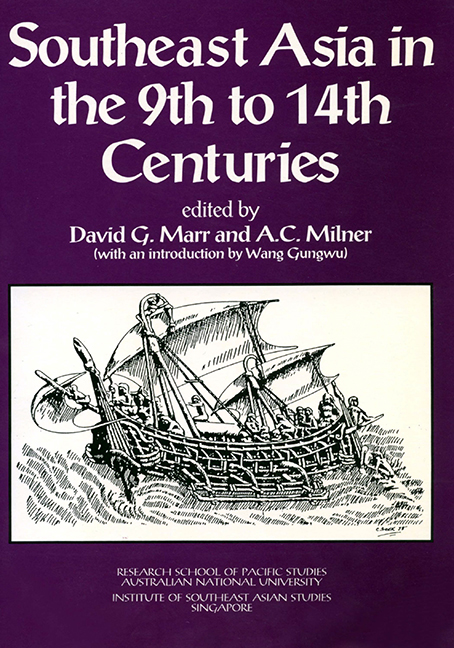Book contents
- Frontmatter
- Contents
- Contributors
- Preface
- Introduction
- 1 The Early and the Imperial Kingdom in Southeast Asian History
- 2 Hydraulic Works and South East Asian Polities
- 3 Some Notes on Relations between Central and Local Government in Ancient Java
- 4 Negara, Mandala, and Despotic State: Images of Early Java
- 5 Some Remarks on Early State Formation in Cambodia
- 6 “Elephants Can Actually Swim”: Contemporary Chinese Views of Late Ly Dai Viet
- 7 Authority and Legitimacy in 11th Century Vietnam
- 8 From Myth to History: Imagined Polities in 14th Century Vietnam
- 9 Shipshape Societies: Boat Symbolism and Political Systems in Insular Southeast Asia
- 10 Changing Perspectives in Island Southeast Asia
- 11 Political and Cultural Continuities at Dvaravati Sites
- 12 The True and the Corbel Arch in Mainland Southeast Asian Monumental Architecture
- 13 Vietnamese Ceramics and Cultural Identity: Evidence from the Ly and Tran Dynasties
- 14 Traditions, Acculturation, Renovation: The Evolutional Pattern of Vietnamese Culture
- 15 Symbolism of Kingship in Arakan
- 16 Buddhism in Champa
- 17 The Ordering of Generations: Change and Continuity in Old Javanese Kinship
- 18 Sources on Economic Activities in Khmer and Cham Lands
- 19 Narrative Bas-Reliefs at Candi Surawana
- 20 Possibilities for a Reading of the 1293-1357 Period in the Vietnamese Annals
- Index
- Miscellaneous Endmatter
14 - Traditions, Acculturation, Renovation: The Evolutional Pattern of Vietnamese Culture
Published online by Cambridge University Press: 21 October 2015
- Frontmatter
- Contents
- Contributors
- Preface
- Introduction
- 1 The Early and the Imperial Kingdom in Southeast Asian History
- 2 Hydraulic Works and South East Asian Polities
- 3 Some Notes on Relations between Central and Local Government in Ancient Java
- 4 Negara, Mandala, and Despotic State: Images of Early Java
- 5 Some Remarks on Early State Formation in Cambodia
- 6 “Elephants Can Actually Swim”: Contemporary Chinese Views of Late Ly Dai Viet
- 7 Authority and Legitimacy in 11th Century Vietnam
- 8 From Myth to History: Imagined Polities in 14th Century Vietnam
- 9 Shipshape Societies: Boat Symbolism and Political Systems in Insular Southeast Asia
- 10 Changing Perspectives in Island Southeast Asia
- 11 Political and Cultural Continuities at Dvaravati Sites
- 12 The True and the Corbel Arch in Mainland Southeast Asian Monumental Architecture
- 13 Vietnamese Ceramics and Cultural Identity: Evidence from the Ly and Tran Dynasties
- 14 Traditions, Acculturation, Renovation: The Evolutional Pattern of Vietnamese Culture
- 15 Symbolism of Kingship in Arakan
- 16 Buddhism in Champa
- 17 The Ordering of Generations: Change and Continuity in Old Javanese Kinship
- 18 Sources on Economic Activities in Khmer and Cham Lands
- 19 Narrative Bas-Reliefs at Candi Surawana
- 20 Possibilities for a Reading of the 1293-1357 Period in the Vietnamese Annals
- Index
- Miscellaneous Endmatter
Summary
Until her contact with, then enslavement by, Western capitalist colonialism, Vietnam was a bureaucratic-monarchic country with a clear-cut social stratification. At the top stood the KING & MANDARINATE, with the COMMON PEOPLE below. Confucianism was the state and social ideology.
That Confucian bureaucratic-monarchic regime of absolute centralism, which lasted from the beginning of the XVth century to the middle of the XlXth century, was not an authentic product, an endogenous element of the water-rice civilization and village culture of Southeast Asia as a whole. It was an exogenous element originating from North China and introduced in the region of water-rice civilization at the period of Chinese domination, and, as an irony of history, received a particular boost from the time Dai Viet shook off the Ming yoke in the beginning of the XV century (1407-1427).
The genuine social product of the cultivation of wet rice was rather the small agricultural villages and hamlets composed of nuclear families, the “husband ploughing, wife transplanting and a buffalo drawing the harrow” type, with the MOTHER and WIFE playing important parts. Its pre-state and proto-state form was made up of a system of local leaders in different regions (“muòng”), who could be referred to as “Lạc lords”, as opposed to “Lạc people”. There was a distinction between ‘lang’ (sir) and “thâng” (fellow), between “nâng” (lady) and “ả” (wench), between aristocrats still maintaining “blood ties” as a ruling instrument and plebeians having lost lineage relations and fragmenting into individual families. In that mandala - as O.W. Wolters put it - of the regime of local leaders, there gradually emerged to the front the role of the “muòng luang” (great “muòng”) leader, who became an overlord, a kind of “pò khun”, later referred to in history as King Hung, with unsophisticated politics, ingenuous? customs and no script.
However, after the fall of the Cô Loa citadel (“Kẻ Chủ”) on the bank of the Nam Luong (Duong river), the Viet country and people were harnessed to the expansionist chariot of Chinese dynasties, from Han to T'ang. Vietnam's fate was linked to Chinese civilization - in the form of a by-product, i.e. as a Chinese “district” and “dominion” - throughout more than a thousand years, and still remained so in a geo-political sense in the subsequent thousand years.
- Type
- Chapter
- Information
- Southeast Asia in the 9th to 14th Centuries , pp. 271 - 278Publisher: ISEAS–Yusof Ishak InstitutePrint publication year: 1986

